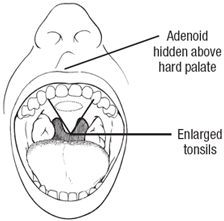Medical Conditions
Tonsils and the Adenoid
Print, Share, or View Spanish version of this article
 In years past, it was very common for children to have their tonsils and the adenoid taken out. Today, doctors know much more about tonsils and the adenoid and are more careful about recommending removal.
In years past, it was very common for children to have their tonsils and the adenoid taken out. Today, doctors know much more about tonsils and the adenoid and are more careful about recommending removal.
Tonsils and the adenoid: what are they?
The tonsils are oval-shaped, pink masses of tissue on both sides of the throat. Tonsils can be different sizes for different children. They can be large or small. There is no “normal” size. You can usually see the tonsils by looking at the back of the mouth with a flashlight. Pressing on the tongue may help, but this makes many children gag. The uvula, a fleshy lobe that hangs down in the back of the mouth, should not be mistaken for the tonsils.
The adenoid is often referred to as “adenoids.” This is incorrect because the adenoid is actually a single mass of tissue. The adenoid is similar to the tonsils and is located in the very upper part of the throat, above the uvula and behind the nose. This area is called the

What is tonsillitis?
Tonsillitis is an inflammation of the tonsils usually due to infection. There are several signs of tonsillitis, including:
-
Red and swollen tonsils
-
White or yellow coating over the tonsils
-
A “throaty” voice
-
Sore throat
-
Uncomfortable or painful swallowing
-
Swollen lymph nodes (“glands”) in the neck
-
Fever
What are the symptoms of an enlarged adenoid?
It is not always easy to tell when your child’s adenoid is enlarged. Some children are born with a larger adenoid. Others may have temporary enlargement of their adenoid due to colds or other infections. This is especially common among young children. Constant swelling or enlargement can cause other health problems such as ear and sinus infections. Some signs of adenoid enlargement are:
-
Breathing through the mouth instead of the nose most of the time
-
Nose sounds “blocked” when the child talks
-
Noisy breathing during the day
-
Snoring at night
Both the tonsils
-
Breathing stops for a short period of time at night during snoring or loud breathing (this is called “sleep apnea”).
-
Choking or gasping during sleep.
-
Difficulty swallowing, especially solid foods.
-
A constant “throaty voice,” even when there is no tonsillitis.
Treatment
If your child shows any of these signs or symptoms of enlargement of the tonsils or the adenoid, and doesn’t seem to be getting better over a period of weeks, talk to your pediatrician. In many children, the tonsils and adenoid become enlarged without obvious infection. They often shrink without treatment.
According to the guidelines of the American Academy of Pediatrics, your pediatrician may recommend surgery for the following conditions:
-
Tonsil or adenoid swelling that makes normal breathing difficult (this may or may not include sleep apnea).
-
Tonsils that are so swollen that your child has a problem swallowing.
-
An enlarged adenoid that makes breathing uncomfortable, severely alters speech and possibly affects normal growth of the face. In this case, surgery to remove only the adenoid may be recommended.
-
Your child has repeated ear or sinus infections despite treatment. In this case, surgery to remove only the adenoid may be recommended.
-
Your child has an excessive number of severe sore throats each year.
-
Your child’s lymph nodes beneath the lower jaw are swollen or tender for at least six months, even with antibiotic treatment.
How do I prepare my child for surgery?
Though it is not as common as it once was, some children need to have their tonsils and/or adenoid taken out. If your child needs surgery, make sure he or she knows what will happen before, during, and after surgery. Don’t keep the surgery a secret from your child. Surgery can be scary, but it’s better to be honest than to leave your child with fears and unanswered questions.
The hospital may have a special program to help you and your child get familiar with the hospital and the surgery. If the hospital allows, try to stay with your child during the entire hospital visit. Let your child know you’ll be nearby during the entire operation. Your pediatrician can also help you and your child understand the operation and make it less frightening in the process. A little ice cream afterwards won’t hurt either.



